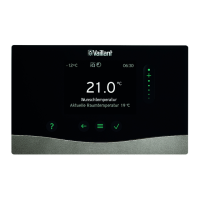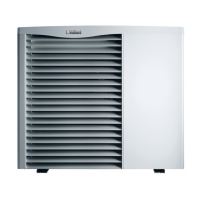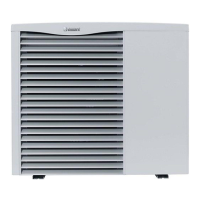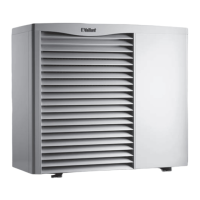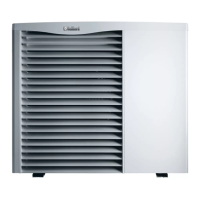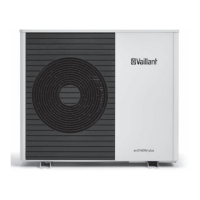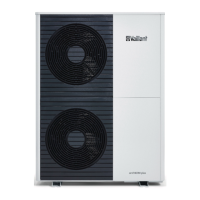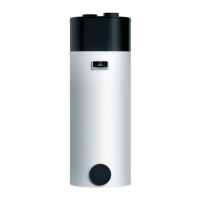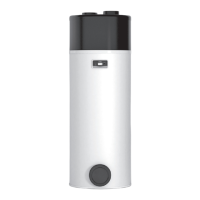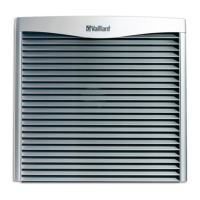Repair and service 13
0020297937_01 aroTHERM plus Installation and maintenance instructions 131
Danger!
Risk of death caused by fire or explosion
if there is a leak in the refrigerant circuit!
The product contains the combustible refri-
gerant R290. In the event of a leak, escaping
refrigerant may mix with air to form a flam-
mable atmosphere. There is a risk of fire and
explosion.
▶ If you are working on the product when it
is open, before starting work, use a gas
sniffer to ensure that there is no leak.
▶ In the case of a leak: Close the product's
housing, inform the end user, and notify
customer service.
▶ Keep all ignition sources away from the
product. In particular, open flames, hot
surfaces with temperatures above 370 °C,
electrical devices that are not free from
electrical sources, static discharges.
▶ Ensure that the room is sufficiently aer-
ated around the product.
▶ Use a restriction to ensure that unauthor-
ised personnel cannot enter the protective
zone.
▶ Switch off all of the disconnectors to which the product is
connected in the building.
▶ Disconnect the product from the power supply but ensure
that the product is still earthed.
▶ Restrict the working area and put up warning signs.
▶ Wear suitable personal protective equipment and bring a
fire extinguisher with you.
▶ Use only safe units and tools that are permitted for R290
refrigerant.
▶ Monitor the atmosphere in the working area using a suit-
able gas detector that is positioned close to the floor.
▶ Remove all ignition sources, e.g. tools that are not spark-
free. Take protective measures to prevent static dis-
charges.
▶ Remove the top casing, the front casing and the right-
hand side casing.
13.2 Removing/installing components of the
refrigerant circuit
13.2.1 Removing the component
▶ Remove the refrigerant from the product. (→ Page 131)
▶ Rinse the refrigerant circuit with nitrogen.
▶ Drain the refrigerant circuit.
▶ Repeat the process of rinsing with nitrogen and draining
until there is no longer any refrigerant in the refrigerant
circuit.
▶ If you want to remove the compressor in which the com-
pressor oil is located, use sufficient negative pressure
to drain it for long enough to guarantee that there is no
longer any combustible refrigerant in the compressor oil.
▶ Establish the atmospheric pressure.
▶ Use a pipe cutter to open the refrigerant circuit. Do not
use soldering equipment or sparking or chipping tools.
▶ Remove the component.
▶ Note that removed components could continue to release
refrigerant for a long time due to outgassing from the
compressor oil contained in the components. This applies
in particular for the compressor. Only store and transport
these components in well-aerated locations.
13.2.2 Installing a component
▶ Install the component correctly.
▶ Carry out a pressure test of the refrigerant circuit using
nitrogen.
▶ Fill the product with refrigerant. (→ Page 132)
▶ Check the refrigerant circuit for leak-tightness using
a gas sniffer. Check the individual components and
pipelines.
13.3 Completing repair and service work
▶ Installing the casing sections.
▶
Switch on the power supply and the product.
▶ Start up the product. Temporarily activate the heating
mode.
▶ Check the product for leak-tightness using a gas sniffer.
13.4 Removing refrigerant from the product
Danger!
Risk of death caused by fire or explosion
when removing the refrigerant!
The product contains the combustible refri-
gerant R290. The refrigerant may mix with air
to form a flammable atmosphere. There is a
risk of fire and explosion.
▶ Only carry out the work if you are compet-
ent at handling R290 refrigerant.
▶ Wear suitable personal protective equip-
ment and bring a fire extinguisher with
you.
▶ Only use tools and units that are permitted
for R290 refrigerant and are in proper
working condition.
▶ Ensure that no air gets into the refrigerant
circuit, into refrigerant-carrying tools or
units, or into the refrigerant cylinder.
Caution.
Risk of material damage when removing
the refrigerant.
When removing the refrigerant, there is a risk
of material damage caused by freezing.
▶ If no system separation is present, re-
move the heating water from the con-
denser (heat exchanger) before the re-
frigerant is removed from the product.
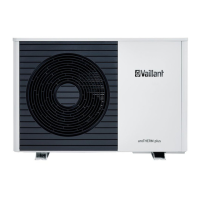
